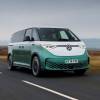
RAC sale – up to 33% off*
• Roadside cover from £5.29 a month†
• We get to most breakdowns in 60 mins or less
• Our patrols fix 4/5 breakdowns on the spot

BY JONATHAN CROUCH
Introduction
Back in the late 1980s, Volkswagen spotted a market niche. Buyers were starting to move away from Golf GTis and into more expensive sports saloons, like the BMW 3 Series. The draw of a smooth and powerful six-cylinder engine was proving very tempting for many.
The six-cylinder Golf VR6 appeared in 1992, and was an instant success. At a stroke, it won back old customers and lifted the Golf upmarket. A new benchmark for high performance hatchbacks had been established.
Models
Models Covered:
3 & 5dr hatchback 2.8 V6[VR6, VR6 Highline]
History
Right hand drive VR6s arrived in the UK in March 1992. Both three and five-door hatchbacks use the same 2.8-litre V6 engine. The engine's design was unusual in that the angle of the 'V' is extremely narrow. This allowed it to fit under the Golf's bonnet, in place of the four-cylinder motors used across the rest of the range.
Modifications to the trim specification followed six months after launch - both the steering column and front seats became height adjustable in September 1992. This was the first of what would prove to be many changes to the car. Stories of poor reliability of some components began to surface and Volkswagen acted several times to correct the suspect parts in 1993 and 1994.
Automatic transmission arrived as an option in February 1993. Later that year, Volkswagen anticipated new European safety laws by fitting twin airbags as standard. Apart from the addition of an engine immobiliser in November 1994, the car remained much the same, though a leather and air conditioning-equipped 'Highline' version was added to the range in 1995.
When the new MKIV Golf was launched in the UK in Spring 1998, there was no VR6 version (though there was an unusual 2.3-litre V5; the V6 with one cylinder lopped off). The V6 wasn't to follow until mid 2000 with 4-Motion 4WD as standard.
What You Get
With the demise of Volkswagen's former performance leader, the Corrado, many new Volkswagen buyers now turn to used versions of the six-cylinder Golf. It offers storming performance in a compact package.
New, the VR6 was always well equipped and so most older cars also offer quite a good standard spec.
Expect to find power steering, anti-lock brakes, alloy wheels and traction control. Many cars have the optional Highline leather trim and air-conditioning. The latter tended to be popular, as heat-soak from the engine was observed in many road tests - the result of a big engine in a relatively small car.
What You Pay
Please fill in the form here for an exact up-to-date information.
What to Look For
Volkswagens, generally, have a name for reliability and excellent build quality. The Golf is no exception, though it's always best to have any high-performance car thoroughly checked for accident damage and telltale signs of an over-enthusiastic former driver. Unevenly worn tyres, graunchy synchromesh on second gear and worn-out shock absorbers are all evidence of abuse. Engines are fairly unburstable, but do check for oil, coolant and power steering fluid leaks. Inside Highline models, check the leather upholstery for excessive wear and damage and ensure the air conditioner delivers chilled air immediately after starting the engine - both items are expensive to repair.
A full service history is highly desirable, especially one from a Volkswagen main dealer. It may be a Volkswagen Golf but it's certainly a more complicated car than its smaller siblings. Parts are readily available from Volkswagen dealers and not overly expensive, when you consider the almost-supercar performance of the VR6.
Replacement Parts
(Approx) For a new clutch, expect to pay around £55. A catalytic converter will set you back £450, while the exhaust system itself is £220. An alternator is about £500, a headlight £65 and front brake pads £60.
On the Road
This is the area where a VR6 will really make you smile. Though some journalists gave the car a bad press for alleged under-damping and soft springing, many owners preferred this set-up to that of the firmer-riding Golf GTi.
The VR6 is one of those rare cars that is equally comfortable on a winding B road, in traffic or else sitting at a constant 70mph on the motorway.
Overall
Near-supercar performance wrapped in a sensible Volkswagen package. A lot of car with a lot of speed for not a lot of money.







